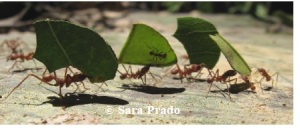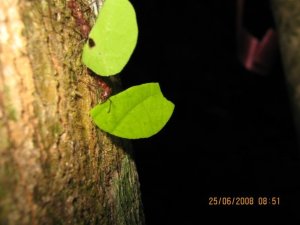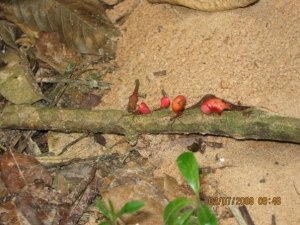Walking along the trails of Reserva Amazonica, it is very likely that you will encounter these amazing ants known as leafcutter ants. 15 species of Atta are known, all situated in the New World, but only 1 of these species can be found around the lodge, known as Atta cephalotes. The genera Atta and their close relative Acromyrmex are unique in that they are the only animals with the ability to grow fungi on fresh vegetation that they bring to their nest.
Unlike many may assume, Atta do not feed on the plant cuttings they bring down from the trees. They use the vegetation as a fertilizer to grow their ‘crop’ which consists of masses of thread shaped hyphae that look somewhat like bread mold. (Holldobler and Wilson). The fungus gardens are set up in the centre of the nest, where the queen can be found laying her eggs, which makes it very convenient for the larvae. All in all, this seems like the perfect symbiosis, however, since this agriculture is a monoculture, the fungus is particularly prone to parasites. Atta ants have found a solution to that problem, though, by excreting a filamentous bacterium of the genus Pseudonocardia, a micro-organism which produces an antibiotic active against a fungal parasite harmful to the ant cultivar (Keller and Gordon).
The fungus cultivation is a process requiring many small steps, conducted in underground chambers, by a series of different castes, in the form of an assembly line. Each step is accomplished by a series of different castes, all varying in size, where the smallest gardener ant is about 300 times lighter than the largest soldier. To begin, the first and largest workers are in charge of leaf harvest. Once the leaves are harvested they are brought to the nest where they are dropped onto the floor of a chamber where they are picked up by a slightly smaller worker. This worker picks up the leaf and cuts it into fragments of a few millimeters in size. Next, an even smaller ant takes over and crushes and molds the fragments into moist pellets, which are then inserted into a pile of this same material. This mass, resembling a grey bath sponge, is fluffy and delicate and full of little channels. It is on the surface of these channels that the fungus is cultivated, digesting the abundant cellulose and proteins available. The fungus is then tended to by even smaller worker ants, which are in charge of plucking strands of hyphae from less dense growth to the newly formed substrate. During the final stage, the smallest and most abundant workers are in charge of patrolling the beds of fungal strands, licking them clean and removing the spores and hyphae of foreign species of mold. After all this labor, the fungus is ready to be consumed. It is this fungus, along with the leaf sap, that the ants eat.

Watchful little leaf cutter ant sits on a leaf while the worker ants carry the leaves to the nest. This little ant keeps an eye out for a parasitic fly that can lay eggs in the workers head, eventually decapitating them.
Colonies of Atta can reach a maximum size of 5-8 million ants per nest (found in Atta sexdens). Such a large colony can consume as much vegetation as a grown cow, in one single day (Holldobler and Wilson). Due to this fact, many are considered as pests in Central and South America, destroying billions of dollars of crops each year. On the other hand, they can also be considered keystone species with respect to soil fertilization. They turnover and aerate the forest and grassland soils and therefore allow for the circulation of nutrients.
In her long lifetime, reaching some 14-20 years of age, the queen can produce as many as 150 million daughters, mostly consisting of workers. The non-workers consist of soldiers, virgin queens and males. Soldiers are only produced when the colony size exceeds 10,000 workers. When the queens are produced, before leaving the nest to go off and mate, the virgin queens take a piece of the fungus from the nest’s garden and store it in a specialized pouch situated in the bottom of her mouth cavity. When ready to leave the nest, all the virgin queens take off in flight to find their mate. They may mate with as many as five or more males in a row. In the end, the queens may receive more than 200 million or more sperm. Once the mating process is over, the males die within one or two days. The queens, on the other hand, fly down to the ground and clip off their wings to live the rest of their live as fully terrestrial insects.
Upon landing to the ground, the queen digs a vertical column about 30cm deep and 12-15mm in diameter. At the base of this column, the shaft is widened to form a small chamber 6cm across. It is in this small chamber that the queen will labour to begin her colony. She first spits out the piece of fungus she had taken from her original nest and lays a few eggs, apart from the fungus. The eggs are produced as the sperm collected from the males, stored in the queen’s spermatheca, are gradually released to fertilize her eggs. After about two weeks, some 20 eggs have been laid and the fungus has grown to about ten times its original size. It is at this point that the queen brings the eggs and fungus together. At the end of the first month, some eggs have hatched and there are now larvae as well as some having reached the first pupal stage. Once the colony has been around for about 40-60 days, the first adult workers emerge and finally can take over the work of cultivating the fungus garden. During the entire process until the first workers emerge from the nest and start to forage around the nest area, the queen subsists on the energy from the breakdown of her body fat and the breakdown and metabolism of the wing muscles. Once the leaves are cultivated, the fungus growth can be tended to by the workers, allowing for the queen to become an ‘egg-laying-machine’ for the rest of her life.



